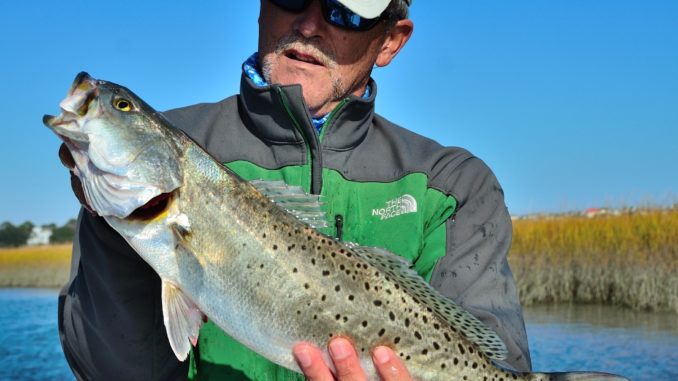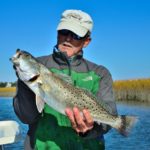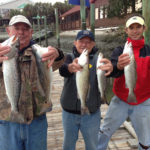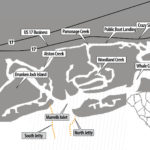
Trolling hard or soft-plastic baits can put you in touch with plenty of Murrells Inlet specks.
As the holiday season approaches, Mother Nature brings Murrells Inlet’s inshore anglers an early Christmas present: the speckled trout flurry continues even though the bait bucket is empty.
With the natural food largely missing, trout will gobble up just about any artificial lure that resembles a normal menu item. That means fishermen can test out their collection of grubs, crankbaits, soft-plastic shrimp and topwater baits next to marsh grass, jetties and oyster beds.
Guide Jason Burton of Fly Girl Fishing Charters relishes the December conditions when the days of catching live bait are over. A handful of rods rigged with MirrOlure, artificial shrimp, topwater plugs, and grubs are all he needs to put a limit of fish in his fish box.
“Many people stop fishing in December when the shrimp disappear, but the trout fishing can be off the charts on artificials,” said Burton (843-798-9100). “We will cast and troll a wide selection of grubs, hard baits, and imitation shrimp.”
Locating December trout is not much different than November. Anglers can expect to find them in a variety of the usual spots, from the jetties to the many oyster-encrusted creeks scattered from Huntington Beach State Park northward to the Horry County line. With water temperatures dropping fast, Burton selects areas capable of supporting trout into the cooler months.
“The best places are places where there is deep water adjacent to a shell-covered bank,” he said. “Fish anywhere there is swift current, like a creek mouth, shell bank, or places where deep water runs into shell bank.”
Trout are easy to pattern in December, and Burton urges anglers to take note of the depth where they are catching fish.
“Trout are depth sensitive. If you start catching trout in 15 feet of water in one spot, you can just about guarantee they will be in a similar spot in 15-foot water,” he said.
From the main creeks to the jetty rocks, trolling is one of the most-popular methods to catch trout in late fall, and for good reason. Trolling allows fishermen to cover a lot of water with a wide variety of lures to both figure out where the fish are and which baits they’ll hit.
Burton trolls MirrOlures to locate schools of trout, which are notorious for playing hide-and-seek with anglers during the fall and winter. While trout will make significant movements during the course of a season, they will only move short distances over the course of a day within the places they are typically known to frequent.
“Trout are like bluefish. You might catch them in one spot one day, and then they will not be back in that same spot for a week. Trolling solves this problem for us giving away their new hideout,” Burton said.
Burton trolls two rods rigged with either a MirrOlure 52M or Yo-Zuri Crystal Shrimp. He slow-trolls against and with the current, bumping his boat in and out of gear to keep lures in the strike zone. But his best successes come from a secondary trolling tactic that allows him to fill his fish box more quickly than traditional trolling methods.
“About every 30 seconds, give a rod a swift little jerk, and the sporadic action will give you a bite much quicker than just trolling alone,” he said.
Even though trolling is a solid strategy for reaching a 10-fish limit, traditional casting techniques can offer constant hooksets under fall conditions, and casting happens to be Burton’s favorite tactic.
“I like to throw Saltwater Assassin curlytail grubs on ¼-ounce jigheads into the current and allow them to bounce along the bottom,” he said.
While Murrells Inlet’s salty paradise is well known for its fantastic seafood restaurants, water sports and even the goats on Drunken Jack Island, for the cold-tempered angler, the fall speckled trout flurry outshines them all.
DESTINATION INFORMATION
WHEN TO GO — The speckled trout bite amps up in October, and the flurry will continue until the end of the year. As long as water temperatures remain stable in the lower 60s or upper 50s, trout will be feeding.
HOW TO GET THERE — Murrells Inlet, at the southern tip of the Grand Strand, is easily accessible from the public boat ramp on US 17 Business, just south of the heart of Murrells Inlet’s famous restaurant district. Despite being relatively small in area, Murrells Inlet is full of prime habitat for specks, including the rock jetties at the inlet’s entrance, plenty of oysters and a handful of promising creeks: Oaks, Alson, Parsonage, Garden City, Main and several smaller creeks along Main Creek. Trout will stay close to deep water in areas with consistent current flow, around abrupt depth changes. In typical December conditions, anglers can expect trout to be set up on the deep side of the structure.
BAITS/TECHNIQUES — At dawn and dusk, topwater walk-the-dog baits from three to five inches long are preferred fished close to structure or the edge of the marsh. MirrOlure 52M, Yozuri Crystal Shrimp and a collection of Saltwater Assassin, Logic, and Egret soft plastics on ¼-ounce jigheads can be trolled or cast along the jetties or shell banks in deeper water. Soft-plastic shrimp are ideal lures under December conditions, since trout will always have a taste for shrimp.
TACKLE/GEAR — Baitcasting and spinning gear perform well with artificial lures, with medium- to medium-light action rods in 6 ½- to 7-foot lengths. Braided line is preferred in the 10- to 14-pound class. In addition, a 15- to 24-inch section of 14- to 20-pound fluorocarbon leader should be used.
GUIDES/FISHING INFO — Capt. Jason Burton, Fly Girl Fishing Charters, 843-798-9100; Perry’s Bait & Tackle, 843-651-2895; Pawley’s Island Outdoors, 843-979-4666. See also Guides and Charters in Classifieds.
ACCOMMODATIONS — Murrells Inlet Hampton Inn, 843-651-6687; Myrtle Beach Area Convention and Visitors Bureau (www.visitmyrtlebeach.com); South Carolina Association of Visitors Bureaus, www.discoversouthcarolina.com.
MAPS — Navionics, 800-848-5896, www.navionics.com; Waterproof Charts, Near shore No. 98, 800-423-9026, www.waterproofcharts.com; SeaLake Fishing Guides, 800-411-0185.







Be the first to comment